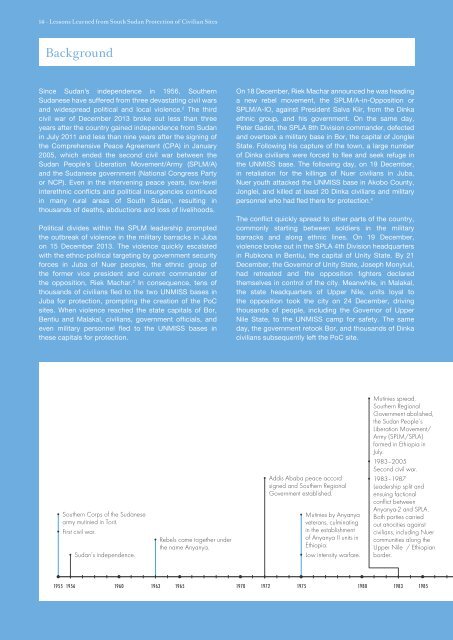Lessons Learned from South Sudan Protection of Civilian Sites 2013–2016
1rTWN7V
1rTWN7V
You also want an ePaper? Increase the reach of your titles
YUMPU automatically turns print PDFs into web optimized ePapers that Google loves.
14 - <strong>Lessons</strong> <strong>Learned</strong> <strong>from</strong> <strong>South</strong> <strong>Sudan</strong> <strong>Protection</strong> <strong>of</strong> <strong>Civilian</strong> <strong>Sites</strong><br />
Background<br />
Since <strong>Sudan</strong>’s independence in 1956, <strong>South</strong>ern<br />
<strong>Sudan</strong>ese have suffered <strong>from</strong> three devastating civil wars<br />
and widespread political and local violence. 2 The third<br />
civil war <strong>of</strong> December 2013 broke out less than three<br />
years after the country gained independence <strong>from</strong> <strong>Sudan</strong><br />
in July 2011 and less than nine years after the signing <strong>of</strong><br />
the Comprehensive Peace Agreement (CPA) in January<br />
2005, which ended the second civil war between the<br />
<strong>Sudan</strong> People’s Liberation Movement/Army (SPLM/A)<br />
and the <strong>Sudan</strong>ese government (National Congress Party<br />
or NCP). Even in the intervening peace years, low-level<br />
interethnic conflicts and political insurgencies continued<br />
in many rural areas <strong>of</strong> <strong>South</strong> <strong>Sudan</strong>, resulting in<br />
thousands <strong>of</strong> deaths, abductions and loss <strong>of</strong> livelihoods.<br />
Political divides within the SPLM leadership prompted<br />
the outbreak <strong>of</strong> violence in the military barracks in Juba<br />
on 15 December 2013. The violence quickly escalated<br />
with the ethno-political targeting by government security<br />
forces in Juba <strong>of</strong> Nuer peoples, the ethnic group <strong>of</strong><br />
the former vice president and current commander <strong>of</strong><br />
the opposition, Riek Machar. 3 In consequence, tens <strong>of</strong><br />
thousands <strong>of</strong> civilians fled to the two UNMISS bases in<br />
Juba for protection, prompting the creation <strong>of</strong> the PoC<br />
sites. When violence reached the state capitals <strong>of</strong> Bor,<br />
Bentiu and Malakal, civilians, government <strong>of</strong>ficials, and<br />
even military personnel fled to the UNMISS bases in<br />
these capitals for protection.<br />
On 18 December, Riek Machar announced he was heading<br />
a new rebel movement, the SPLM/A-in-Opposition or<br />
SPLM/A-IO, against President Salva Kiir, <strong>from</strong> the Dinka<br />
ethnic group, and his government. On the same day,<br />
Peter Gadet, the SPLA 8th Division commander, defected<br />
and overtook a military base in Bor, the capital <strong>of</strong> Jonglei<br />
State. Following his capture <strong>of</strong> the town, a large number<br />
<strong>of</strong> Dinka civilians were forced to flee and seek refuge in<br />
the UNMISS base. The following day, on 19 December,<br />
in retaliation for the killings <strong>of</strong> Nuer civilians in Juba,<br />
Nuer youth attacked the UNMISS base in Akobo County,<br />
Jonglei, and killed at least 20 Dinka civilians and military<br />
personnel who had fled there for protection. 4<br />
The conflict quickly spread to other parts <strong>of</strong> the country,<br />
commonly starting between soldiers in the military<br />
barracks and along ethnic lines. On 19 December,<br />
violence broke out in the SPLA 4th Division headquarters<br />
in Rubkona in Bentiu, the capital <strong>of</strong> Unity State. By 21<br />
December, the Governor <strong>of</strong> Unity State, Joseph Monytuil,<br />
had retreated and the opposition fighters declared<br />
themselves in control <strong>of</strong> the city. Meanwhile, in Malakal,<br />
the state headquarters <strong>of</strong> Upper Nile, units loyal to<br />
the opposition took the city on 24 December, driving<br />
thousands <strong>of</strong> people, including the Governor <strong>of</strong> Upper<br />
Nile State, to the UNMISS camp for safety. The same<br />
day, the government retook Bor, and thousands <strong>of</strong> Dinka<br />
civilians subsequently left the PoC site.<br />
• <strong>South</strong>ern Corps <strong>of</strong> the <strong>Sudan</strong>ese<br />
army mutinied in Torit.<br />
• First civil war.<br />
• <strong>Sudan</strong>’s independence.<br />
• Rebels came together under<br />
the name Anyanya.<br />
• Addis Ababa peace accord<br />
signed and <strong>South</strong>ern Regional<br />
Government established.<br />
• Mutinies by Anyanya<br />
veterans, culminating<br />
in the establishment<br />
<strong>of</strong> Anyanya II units in<br />
Ethiopia.<br />
• Low intensity warfare.<br />
• Mutinies spread,<br />
<strong>South</strong>ern Regional<br />
Government abolished,<br />
the <strong>Sudan</strong> People’s<br />
Liberation Movement/<br />
Army (SPLM/SPLA)<br />
formed in Ethiopia in<br />
July.<br />
• 1983–2005<br />
Second civil war.<br />
• 1983–1987<br />
Leadership split and<br />
ensuing factional<br />
conflict between<br />
Anyanya-2 and SPLA.<br />
Both parties carried<br />
out atrocities against<br />
civilians, including Nuer<br />
communities along the<br />
Upper Nile / Ethiopian<br />
border.<br />
1955 1956 1960 1963 1965 1970 1972 1975<br />
1980 1983 1985


